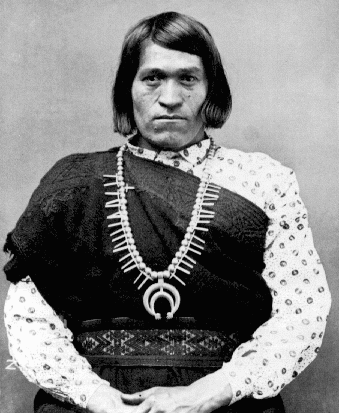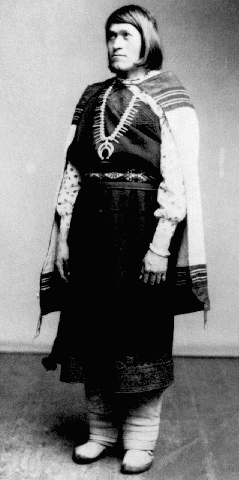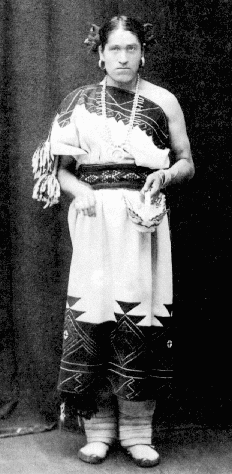Jonathan Ned Katz: "We'wha Went to Washington", 1886
"She is a man"
This essay, first published in The Advocate in the 1980s, has been reedited for publication on OutHistory.org. Last edit: February 9, 2011.[1]
In 1886, a tall, broad-shouldered, evidently female potter and weaver of the Zuni Pueblos of western New Mexico traveled to Washington, D.C., as cultural emissary from her nation. There We'wha (pronounced WEE-wah) met President Grover Cleveland and other notables and dined with some of the "most distinguished women of the national capital."
During her six busy, well-publicized months in Washington, We'wha's performance was greeted with "deafening" applause by congressmen, diplomats, and Supreme Court justices. Throughout her stay, We'wha was the guest of Matilda Coxe Stevenson, the anthropologist, and Stevenson's husband.
In 1904, eight years after We'wha's death, Matilda Stevenson published a long anthropological report on the Zuni. The scholarly pages contained a startling revelation: We'wha "was a man wearing woman's dress!"
"So carefully was his sex concealed," Stevenson admitted, "that for years the writer believed him to be a woman." (So much for this anthropologist's intimate knowledge of a major native informant.)
We'wha was one of those the Zuni called Ihamana. For such people among Native American tribes, anthropologists (following early French explorers) have often used the term berdache, defined as a man who, in the words of independent gay scholar Will Roscoe, "combined the work and social roles of both men and women, an artist and a priest who dressed, at least in part, in women's clothes."
Stevenson did not discuss We'wha's erotic life, but in her 1904 report, the anthropologist says of other Zuni Ihamana: "There is a side to the lives of these men which must remain untold. They never marry women, and it is understood that they seldom have any relations with them." The Ihamanas' sexual relations, Stevenson hints broadly, were mostly with men.
With hindsight, it's amusing to contemplate those ultra-respectable 1886 Washingtonians unknowingly entertaining a Native American berdache, someone they would have most likely condemned as a "sex pervert." It's also intriguing to picture We'wha performing as she did at the National Theater -- an Indian maid played by a clandestine biological male -- and winning the applause of Supreme Court judges. (Surely, there's a theater piece here - a Native American M. Butterfly.)
Roscoe analyzed We'wha's story in an article published by Out/Look magazine. In a subsequent issue of Out/Look, this analysis was hotly contested by historian Ramon A. Gutierrez.
Roscoe suggested that the Native American berdache is best understood not as "crossing" from men's work and roles to women's but as "bridging or combining the social roles of men and women." Roscoe pointed out that We'wha and other berdaches commonly adopted elements of each sex's dress, work, religious functions, and kinship duties "to create a unique synthesis." Berdaches, Roscoe stressed, "were valued precisely because they contributed something neither men nor women offered. Their variance was not ignored or disguised by the social fiction of gender crossing."
According to Roscoe, the Zuni did not regard the roles played by men and women as mutually exclusive opposites. A berdache did not have to be one or the other, man or woman. Without contradiction, the Zuni said of We'wha, "She is a man."
Functioning as a kind of third sex,We'what enacted a "traditional gay role," saiud Roscoe, who sugged that such berdaches could serve as a model for contemporary gay men and lesbians as we struggle to construct ourselves freer than we've been of rigid gender divisions.
In vigorous disagreement with Roscoe, Gutierrez questioned "whether the berdache status in general, [or] the Zuni Indian We'wha in particular, really offers moderns an exemplary 'gay role.' "
At issue in the conflict between Roscoe and Gutierrez is (1) the character of the Zuni lhamana and the berdache within Native American history, (2) our present interpretation of that phenomenon, and (3) the current personal and political implications of that interpretation.
In opposition to Roscoe, Gutierrez maintainedthat the "violent masculine world of Pueblo Indian warriors is the
cultural context" in which we must understand We'wha and other Ihamana. This historian emphasized the origin of the berdache in male warrior culture: "berdache status was one principally ascribed to defeated enemies;" Warriors, "on vanquishing their enemies, asserted their virility by transforming losers into effeminates." The men "pressed into berdache status" were intended "primarily to service and delight the chiefs" as well as to provide a sexual outlet for bachelors, thus preventing "conflicts between men over women.
Gutierrez stressed the low status and ridicule to which the Ihamana specifically - and the berdache in general- were subjected because of their assumption of women's clothes, women's work, and a sexually passive role.
Anthropologists, Gutierrez suggested, often mistakenly ascribed high status to the berdache because, "as marginalized and low-status individuals in the male political world," the berdaches "were quite eagerto to tell their story to anyone willing to listen."
Gutierrez warned that present-day gay people, eager for examples of "a less rigid gender hierarchy," must avoid looking for "gay models where they do not exist." To do so would shroud We'wha and other berdaches in "romantic obfuscations" and impose on them a new "humiliation."
It's impossible for someone who is not a specialist in Native American sexual and gender history to know who is closer to the historical facts, Roscoe or Gutierrez. But their controversy itself is valuable if it goads us toward a deeper, more subtle analysis of LGBT and Native American history.
Both Roscoe and Gutierrez use the word berdache as a general term, thereby implying, that some uniform essence of berdache exists across Native American cultures and throughout history. But doesn't the great variety of names assigned by different tribes to the so-called berdaches suggest that there might have been as great a variety of constructions of this role? Perhaps there is no essential berdache. Perhaps that one term, coined by white people, confuses more than it clarifies. Future research and analysis should help us understand We'wha better.
<comments />
- ↑ original pub data?


